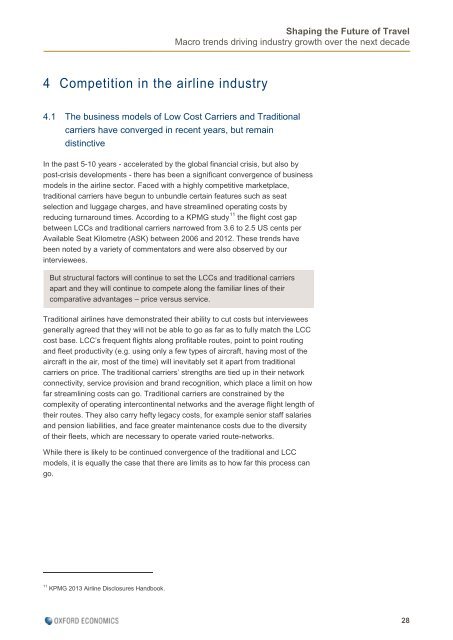Amadeus-Shaping-the-Future-of-Travel-MacroTrends-Report
Amadeus-Shaping-the-Future-of-Travel-MacroTrends-Report
Amadeus-Shaping-the-Future-of-Travel-MacroTrends-Report
Create successful ePaper yourself
Turn your PDF publications into a flip-book with our unique Google optimized e-Paper software.
<strong>Shaping</strong> <strong>the</strong> <strong>Future</strong> <strong>of</strong> <strong>Travel</strong><br />
Macro trends driving industry growth over <strong>the</strong> next decade<br />
4 Competition in <strong>the</strong> airline industry<br />
4.1 The business models <strong>of</strong> Low Cost Carriers and Traditional<br />
carriers have converged in recent years, but remain<br />
distinctive<br />
In <strong>the</strong> past 5-10 years - accelerated by <strong>the</strong> global financial crisis, but also by<br />
post-crisis developments - <strong>the</strong>re has been a significant convergence <strong>of</strong> business<br />
models in <strong>the</strong> airline sector. Faced with a highly competitive marketplace,<br />
traditional carriers have begun to unbundle certain features such as seat<br />
selection and luggage charges, and have streamlined operating costs by<br />
reducing turnaround times. According to a KPMG study 11 <strong>the</strong> flight cost gap<br />
between LCCs and traditional carriers narrowed from 3.6 to 2.5 US cents per<br />
Available Seat Kilometre (ASK) between 2006 and 2012. These trends have<br />
been noted by a variety <strong>of</strong> commentators and were also observed by our<br />
interviewees.<br />
But structural factors will continue to set <strong>the</strong> LCCs and traditional carriers<br />
apart and <strong>the</strong>y will continue to compete along <strong>the</strong> familiar lines <strong>of</strong> <strong>the</strong>ir<br />
comparative advantages – price versus service.<br />
Traditional airlines have demonstrated <strong>the</strong>ir ability to cut costs but interviewees<br />
generally agreed that <strong>the</strong>y will not be able to go as far as to fully match <strong>the</strong> LCC<br />
cost base. LCC’s frequent flights along pr<strong>of</strong>itable routes, point to point routing<br />
and fleet productivity (e.g. using only a few types <strong>of</strong> aircraft, having most <strong>of</strong> <strong>the</strong><br />
aircraft in <strong>the</strong> air, most <strong>of</strong> <strong>the</strong> time) will inevitably set it apart from traditional<br />
carriers on price. The traditional carriers’ strengths are tied up in <strong>the</strong>ir network<br />
connectivity, service provision and brand recognition, which place a limit on how<br />
far streamlining costs can go. Traditional carriers are constrained by <strong>the</strong><br />
complexity <strong>of</strong> operating intercontinental networks and <strong>the</strong> average flight length <strong>of</strong><br />
<strong>the</strong>ir routes. They also carry hefty legacy costs, for example senior staff salaries<br />
and pension liabilities, and face greater maintenance costs due to <strong>the</strong> diversity<br />
<strong>of</strong> <strong>the</strong>ir fleets, which are necessary to operate varied route-networks.<br />
While <strong>the</strong>re is likely to be continued convergence <strong>of</strong> <strong>the</strong> traditional and LCC<br />
models, it is equally <strong>the</strong> case that <strong>the</strong>re are limits as to how far this process can<br />
go.<br />
11 KPMG 2013 Airline Disclosures Handbook.<br />
28


